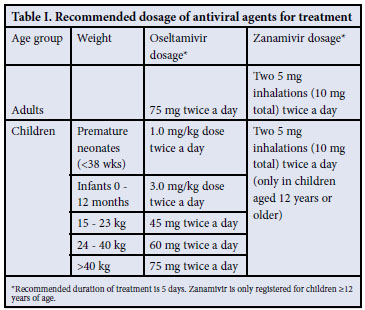Servicios Personalizados
Articulo
Indicadores
Links relacionados
-
 Citado por Google
Citado por Google -
 Similares en Google
Similares en Google
Compartir
SAMJ: South African Medical Journal
versión On-line ISSN 2078-5135
versión impresa ISSN 0256-9574
SAMJ, S. Afr. med. j. vol.101 no.2 Pretoria feb. 2011
FORUM
DRUG ALERT
Recommendations pertaining to the use of viral vaccines: Influenza 2011
For a review of the 2010 influenza season, please refer to the website of the National Institute for Communicable Diseases of the National Health Laboratory Service: www.nicd.ac.za
Recommended vaccine formulation
The following strains have been recommended by the World Health Organization (WHO) for the 2011 Southern Hemisphere influenza season and are the same as the recommendations for the 2010 season:
• an A/California/7/2009 (H1N1)-like virus
• an A/Perth/16/2009 (H3N2)-like virus
• a B/Brisbane/60/2008-like virus.
Vaccines should contain 15 µg of each haemagglutinin antigen in each 0.5 ml dose.
Indications
1. Persons (adults or children) who are at high risk for influenza and its complications because of underlying medical conditions and who are receiving regular medical care for conditions such as chronic pulmonary and cardiac diseases, chronic renal diseases, diabetes mellitus and similar metabolic disorders, individuals who are immunosuppressed (including HIV-infected persons with CD4 counts above 100 cells/µl), individuals who are morbidly obese (BMI >40).
2. Pregnant women, irrespective of stage of pregnancy.
3. Residents of old-age homes, chronic care and rehabilitation institutions.
4. Children on long-term aspirin therapy.
5. Medical and nursing staff responsible for the care of high-risk cases.
6. Adults and children who are family contacts of high-risk cases.
7. All persons over the age of 65 years.
8. Any persons wishing to protect themselves from the risk of contracting influenza, especially in industrial settings, where large-scale absenteeism could cause significant economic losses.
Dosage
• Adults: Whole or split-product or subunit vaccine - 1 dose IM.
• Children (<12 years): Split-product or subunit vaccine - 1 dose IM.
• Children <9 years who have never been vaccinated should receive 2 doses 1 month apart.
• Children <3 years of age should receive half the adult dose on two occasions separated 1 month apart.
• Influenza vaccine is not recommended for infants less than 6 months of age.
Contraindications
1. Persons with a history of severe (anaphylactic) hypersensitivity to eggs or other components of the vaccine.
2. Persons with acute febrile illnesses should preferably be immunised after symptoms have resolved.
Timing
Vaccines should be given sufficiently early to provide protection for the winter. A protective antibody response takes about 2 weeks to develop.
Antiviral chemotherapy
At present novel influenza A (H1N1) and H3N2 and B influenza viruses remains largely sensitive to oseltamivir (as well as zanamivir). The dosages for treatment are provided in Table I.

Antiviral chemoprophylaxis
Chemoprophylaxis for contacts of persons with influenza is not recommended. Recent WHO recommendations advise presumptive treatment using the treatment regimen described above for high-risk (severely immunocompromised) individuals exposed to influenza instead of the previously recommended long-term lower-dose chemoprophylaxis regimen. These individuals need to be very carefully monitored during influenza outbreak season for early signs and should then be treated immediately on suspicion of infection.
For a more detailed description of antiviral management and prophylaxis of influenza, please refer to the Healthcare Workers Handbook on Influenza on the NICD website: http://www.nicd.ac.za
Department of Health
Corresponding author: B D Schoub (barrys@nicd.ac.za)














